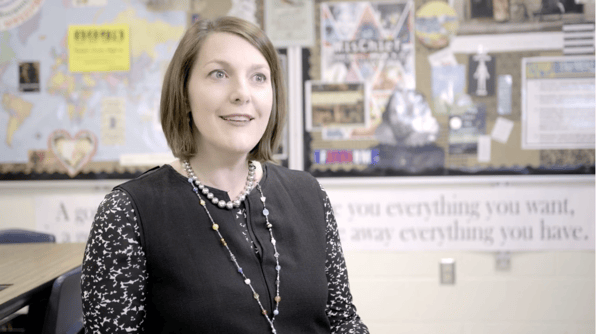
Making Thematic Connections Between Literature and Current Events
When this class used current events to teach the theme of civil disobedience with “Antigone,” students made deeper connections to the Greek tragedy.
Teaching Antigone
When Maggie Walls’s high school class read Antigone, students didn’t always connect to the Greek tragedy. After all, most high school students haven’t had to disobey a law so that they can provide their brother – who waged battle for control of a city – with a proper burial.
But many students can relate to the decision or temptation to break a rule. So when Maggie Walls’s class studied Antigone, they paired it with discussion of civil disobedience in more current events.
Pairing Antigone with Texts about Civil Disobedience
Using the Writing Module “Social Responsibility,” students studied the Preamble to the U.S. Constitution, Henry David Thoreau’s “Civil Disobedience,” and Patrick Henry’s speech to the Second Virginia Convention. These texts – which varied in perspective, subject matter, and reading level – brought all the students back to the same Class Discussion Question of the Writing Module: “How do individuals stand up and take responsibility for changing their societies?”
With these lessons, “I could give students pieces that were thematically similar, but that were just right for them because of that reading level,” Walls said. “We all come back to have a conversation where we’re all pulling [from the text we read], but it was just right for [the student].”
Connecting Antigone to Civil Disobedience in Current Events
After reading Antigone and discussing additional texts on civil disobedience, Walls’s class went a step further: they searched for current events that covered the same theme of disobeying civil law in the hope of yielding change.
By pairing the ancient Greek tragedy with more familiar events, students were able to make deeper personal connections with Antigone’s story and theme. Many students researched the Keystone XL Pipeline Protests at Standing Rock and the Black Lives Matter movement. Earlier in the unit, they had also discussed the Boston Tea Party, Underground Railroad, and Civil Rights protests.
The Final Project: A Website on Civil Disobedience, from Antigone to Today
To bring together the knowledge they had gained from discussing Antigone, historical texts, and current events, the students then created wiki pages that analyzed civil disobedience from Antigone to today. The project instructed:
Take a stand and decide whether acts of civil disobedience are effective. What is the role of civil disobedience today? Find current examples and relate them to Antigone’s struggle against the state. You will design a wiki page that thematically relates Antigone to examples from history and today.
At the end of the unit, students had to make a claim about the effectiveness of civil disobedience. By the time they were ready to write their argument, they had gathered evidence, connected it with reasoning, and learned about counterarguments that spoke to a variety of audiences.
It was a true CERCA, through and through.
Continue your learning about writing in Social Studies:

Mallory Busch is ThinkCERCA's Editor of Content Strategy. A graduate of Northwestern University, Mallory came to ThinkCERCA from stops in audience strategy at TIME magazine and news applications development at Chicago Tribune and The Texas Tribune. She holds degrees in Journalism and International Studies, and was a student fellow at Knight Lab in college.

